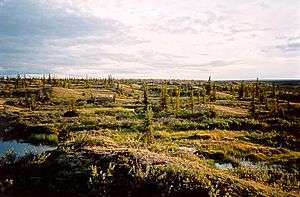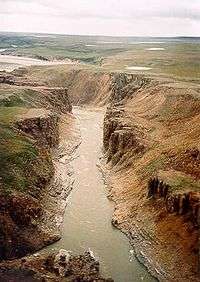Tuktut Nogait National Park
Tuktut Nogait National Park is a national park in the Northwest Territories of Canada.

Understand
Tuktut Nogait National Park covers an area of 18,100 km² (7,000 sq mi), which is larger than Kuwait. It is 170 km (110 mi) north of the Arctic Circle in the northeast corner of mainland Northwest Territories.
Tuktut Nogait means "young caribou" in Inuvialuktun:

The main rivers that run through the park are the Hornaday River, Brock River and Roscoe River.
Contact the park office +1 867-580-3233 or email: Inuvik.info@pc.gc.ca
History
The park was established in 1998.
Humans have occupied Tuktut Nogait since AD 1000 and surveys have identified over 400 archaeological sites in the park, including remnants of campsites, food caches, graves, and kayak rests. The oldest known archaeological sites are most likely Thule or Copper Inuit ranging from AD 1200 to 1500.
Father Émile Petitot was the first European to reach the area in 1867-68. In 1930, the Hudson's Bay Company established an outpost at Letty Harbour but the post was closed in 1937 due to insufficient trade. In 1935, a Roman Catholic Mission was founded at Paulatuk and operated a small trading post there until 1954. The Inuit who came to Paulatuk and the Darnley Bay area were primarily Mackenzie and Alaskan Inuit from the west. In 1955, most people abandoned the Paulatuk mission and moved to Cape Parry where a Distant Early Warning line site was being built, which meant seasonal construction and permanent wage labour work.
As is outlined in the Inuvialuit Final Agreement and the Tuktut Nogait Agreement, Inuvialuit beneficiaries have the right to pursue subsistence harvesting within the park. This takes place in the north-western part of the park and mostly entails fishing Arctic char, hunting caribou, and some trapping. By national parks legislation, commercial or sport hunting is not permitted.
Landscape
Flora and fauna
The park is home to the calving grounds of the Bluenose-West caribou herd, and to muskoxen, grizzly bears, Arctic chars, red foxes, wolverines, Arctic ground squirrels, collared lemmings, and wolves.
Tuktut Nogait is a major breeding and nesting ground for a wide variety of migratory birds. Raptors such as peregrine falcons, rough-legged hawks, gyr falcons and golden eagles nest along the steep walls of river canyons.
The Dolphin-Union Caribou herd which normally occupies Victoria Island and winters in the Bathurst area of Nunavut, sometimes migrates as far as Tuktut Nogait National Park following the shoreline in search of windswept areas where the snow cover is cleared making it easier for them to graze.
Climate
Get in
Tuktut Nogait National Park is open year-round. July is the most reliable weather month. Air charter flights are available to Paulatuk from Inuvik. Charter floatplane access from Norman Wells or Inuvik to several lakes in Tuktut Nogait National Park is available by permit. All visitors to Tuktut Nogait National Park must register with the Parks Canada office in Inuvik and attend an orientation session.
Inuvik is the largest community in the region and is served daily by scheduled aircraft from southern Canada. Aklak Air is the only scheduled aircraft carrier serving the community of Paulatuk. Scheduled flights between Inuvik and Paulatuk are on Tuesday, Wednesday and Friday.
There are no roads or trails to Tuktut Nogait from Paulatuk.
Fees and permits
Northern Park Backcountry Excursion/Camping Permit valid at Tuktut Nogait, Auyuittuq, Ivvavik, Nahanni, Aulavik, Quttinirpaaq, Sirmilik and Vuntut National Parks (per person, 2018):
- Daily $24.50
- Annual $147.20
Fishing permit:
- Daily $9.80
- Annual $34.30